Ref Training Program - The Rules (Article 18)
- Details
- Last Updated on Tuesday, 31 January 2023 22:02
- Written by Russ Scherer
- Hits: 14695
V. The Rules (Article 18)
Article 18 - Prohibited Acts and Penalties
The prohibited acts are divided into infringements that receive the penalty of:
- Shido - two (2) shido can be awarded and a third will be hansoku-make. The athlete is disqualified and can continue in the competition, if applicable.
- Hansoku-make - the athlete is disqualified and can continue in the competition, if applicable.
- Hansoku-make - the athlete is disqualified and cannot continue in the competition.
A contest cannot be decided by single or accumulated shido, until hansoku-make is reached.
Referees are authorized to award penalties according tothe "intention" or situation and in the best interest of the sport.
Should the referee decide to penalise the athlete(s), (except in the case of Sono-mama! in newaza) he shall temporarily stop the contest by announcing mate, should return the athletes to their starting positions (Article 11) and announce the penalty while pointing to the athlete(s) who committed the prohibited act.
Article 18.1 Shido (Slight Infringement Group)
During the contest an athlete can receive a shido for a lack of combativity, an illegal move or action that is not considereddangerous, untidy attire or hair.
Two shido will be given as warnings and the third will be hansoku-make, the athlete is disqualified and can continue in the competition, if applicable.
Shido do not give a score to the other athlete, only technical scores can give points on the scoreboard.
When both athletes infringe the rules at the same time, each should be awawded a penalty according to the seriousness of the infringement.
When both athletes have been given two (2) shido and subsequently each receives a further penalty, they should both be given hansoku-make.
Shido infringements can be evaluated as hansoku-make if done in an obvious anti-sporting manner that is not fair play (e.g., if one athlete stamps on the footof his opponentto throw him more than once, or just to block like crossing fingers to avoid the grip or uke, in an osaekomi situation, puts his hand forcefully on the face of tori to escape.
A penalty in ne-waza should be applied in the same manner as in Article 17 Oseakomi.
If an athlete (blue) commits a slight infringement and his opponent (white with no score) throws him for waza-ari, white will be given waza-ari and blue a shido.
If an athlete (blue) commits a slight infringement and his opponent (white with no score) throws him for ippon, white will be given ippon and the contest ended.
If an athlete (blue) commits a slight infringement and his opponent (white with a waza-ar scoreithrows him for waza-ari or ippon, white will be given ippon and the contest ended.
If an athlete (blue) commits a slight infringement and throws his opponent (white) the referee will allow the ne-waza until white has the advantage. The referee must announce Matte! to give the penalty to blue in the momentthat blue takesthe advantage in ne-waza (e.g. to break the osaekomi-waza and takes over the control, to break the osaekomi-waza by applying shime-waza or kansetsu-waza, waza-ari for throw two elbows or two hands, or one elbow and one hand and continuation in ne-waza); it doesn't matter if it is the first, second or the third shido.
Whenever the referee awards a penalty, he should demonstrate with a simple gesture the reason for the penalty.
A penalty can be awarded after the announcement of Sore-made! for any prohibited act done during the time allotedfor the contestor, in some exceptional situations, for serious acts done after the signal to end the confest. In this case the referee will apply the penal in accordance with the IJF Referee Commission and/or Supervisors.
Article 18.1.1 Shido for a Lack of Combativity
1. Negative positions, against the fighting spirit, will be penalised by shido (to adopt in a standing position, after kumi-kata, an excessively defensive posture, not searching for an attack, a defensive attitude, etc.).
2. To make an action designed to give the impression of an attack but which clearly shows that there was no intent to throw the opponent (false attack). False attacks are defined as:
• Tori has no intention of throwing.
• Tori attacks without kumi-kata or immediately releases the kumi-kata.
• Tori makes a single fake attack or a number of repeated fake attacks with no breaking of uke’s balance.
• Tori puts a leg in between uke’s legs to block the possibility of an attack.
3. Unless in accordance with Article 10, to pull the opponent down to start ne-waza and the latter does not take advantage of this to continue into ne-waza, the referee shall announce Mate! and give shido to the athlete who has infringed Article 10.
4. In a standing position, after the referee has announced Hajime! and before or after kumi-kata has been established, not to make any attacking moves. Recognizing the difficulty of preparing a throwing action, the time between kumi-kata and making an attack is 45 seconds as if there is a positive progression. The referees should penalize strictly the athlete who does not engage in kumi-kata or who tries not to be gripped by the opponent
5. Withot ther being an attack engaged in a valid position (see Article 5 - Exceptions):
- In tachi-waza to go intentionally or intentionally force the opponent to go outside the contest area;
- In ne-waza to go deliberately outside the contest area.
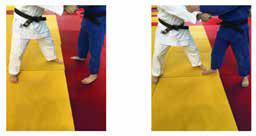
If an athlete puts one foot outside of the contest area without immediate attack or not returning immediately inside the contest area, he is penalized by shido. Two feet outside the contest area is penalized immediately by shido.
Article 18.1.2 - Shido for an illegal move
6. To put a hand, arm, foot or leg directly on the opponent’s face. The face means the area within the line bordered by the forehead, the front of the ears and the jawline.
7. To intentionally avoid taking kumi-kata in order to prevent action in the contest. Normal kumi-kata is taking hold the right side of the opponent’s judogi, be it the sleeve, collar, chest area, top of the shoulder or back with the left hand and with the right hand the left side of the opponent’s judogi be it the sleeve, collar, chest area, top of the shoulder or back and always above the belt or vice versa.
To offer more chances to throw and more attractive judo, non-classical grips are allowed. Collar and lapel, one side, cross grip, belt grip, pocket and pistol grips are allowed when the attitude of the athlete is positive, when they are looking to perform positive attacks and throws. If taken, time will be allowed for the preparation of an attack. The same grip (or a collar and lapel grip) used to force the opponent with either one or both arms, to take a bending position, used as defensive, negative, or blocking attitude, will be penalized by shido.

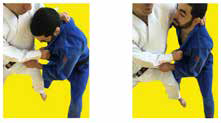


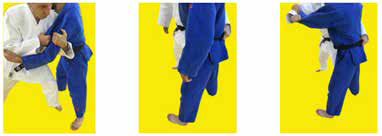
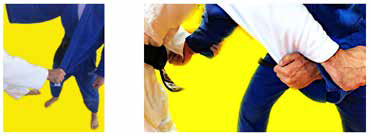
8. To grab below the belt.
Exception: Gripping under the belt in the final phase of a throwing technique is allowed if the opponent is already in ne-waza. If the throwing technique is interupted, gripping under the belt is a ne-waza action.
9. Ducking beneath the opponents arm without an immediate attack will be penalised with shido.
10. Hooking one leg between the opponent's legs unless immediately attacking with a throwing technique.
11. In a standing position, to continually hold the opponent’s sleeve end(s) for a defensive purpose or to grasp by “screwing up” the sleeve end(s).
12. In a standing position, to continually keep the opponent’s fingers of one or both hands interlocked, in order to prevent action in the contest or to take the wrist or the hands of the opponent only to avoid the grip or the attack on him.
13. To insert a finger or fingers inside the opponent’s sleeve or of his trousers either in the ends of the trouser legs or in the waistband (top) of the trousers.
14. To bend back the opponent’s finger(s) in order to break his grip.
15. Breaking the grips with one or two hands and immediately taking grips is allowed. Breaking grips with one or two hands and not taking a grip immediately is shido. Breaking the grip, if after that a grip is still there, is allowed. For example, if the athlete in the blue judogihas one grip and the athlete in the white judogi decides to break with one or two hands, white should keep at least one grip in their hand. So, if blue has one grip, after breaking, white shall keep at least one grip. If after breaking the grip, white does not have any grip anymore, it is shido.

16. To break the grip of the opponent with the knee or leg.
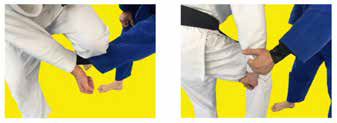
17. Cover the upper part of the lapel of the judogi jacket to prevent the grip
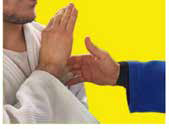
18. Avoid uke’s grip with a blow on his arm or hand.

19. Blocking the opponent’s hand.
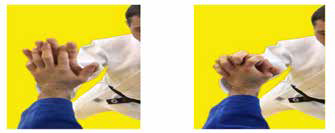
20. Leg grabbing, grabbing the trousers, blocking or pushing the opponent’s leg(s) with their hands or arms. It is possible to grip the leg only when the two opponents are in a clear ne-waza position and the tachi-waza action has stopped.

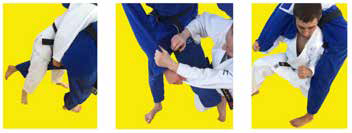
These are valid actions and no shido will be given.

Tori in this tachi-shisei position can apply kansetsu-waza or shime-waza because uke is in a ne-waza position.
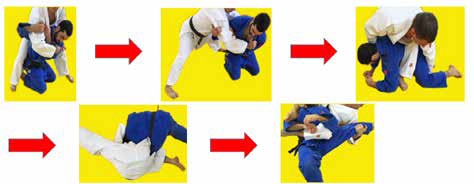
21. To encircle the end of the belt or jacket around any part of the opponent’s body. The act of “encircling” means that the belt or jacket must completely encircle. Using the belt or jacket as an anchor for a grip (without encircling), e.g. to trap the opponent’s arm, should not be penalised.
22. To take the judogi in the mouth (either his own or his opponent’s judogi).
23. To put a foot or a leg in the opponent’s belt, collar or lapel.
24. To apply shime-waza using either your own or your opponent’s belt or bottom of the jacket or using only the fingers
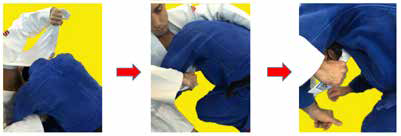
25. In shime-waza or kansetsu-waza over-stretching the leg is forbidden and the referee will announce mate immediately and sanction the athlete with shido.
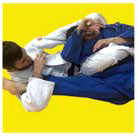
Special attention will be given to situations: where tori, whilst applying a shime-waza, also over-stretches and straightens uke’s leg. Mate must be called immediately and a shido given.
26. To hug directly the opponent for a throw (bear hug).
Precision: To attack with a bear hug the contestant must have a minimum of one grip before making the attack.

It is not valid to grip simultaneously or to make a second grip consecutively. Only touching the judogi or the opponent's hands in order to avoid grips, is not considered as kumi-kata, gripping is necessary.
These are valid grips for bear hug.
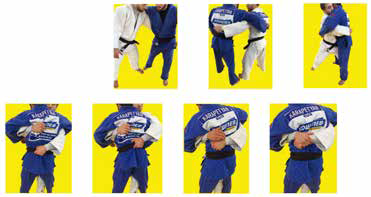
27. To apply leg scissors to the opponent’s trunk (dojime), neck or head (scissor with crossed feet, while stretching out the legs. In shime-waza (e.g. ryote -jime) it is forbidden to use the legs crossed to assist the grip.
28. To kick with the knee or foot, the hand or arm of the opponent, in order to make him release his grip or to kick the opponent’s leg or ankle without applying any technique
29. If both of the contestants are in a tachi-shisei (standing position) and one or both apply kansetsu-waza (including ude gaeshi ((arm reverse)) and similar) or shime-waza (both technical situations alone or combined with a judo throwing technique), Mate! and shido should be announced. However, if the action is dangerous or can injure the opponent, it will be hansokumake.
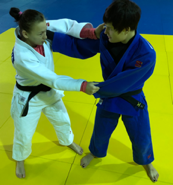
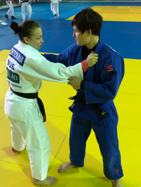
30. The act of entangling the leg without making an immediate attack must be penalised with shido.
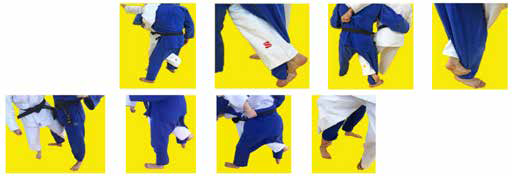
31. No score and shido for reverse seio-nage. The application of seio-nage techniques when uke can perform ukemi and tori can control is allowed. In the variation of seio-nage techniques when tori turns away from uke, twisting their tsurite and hikite using the sake lapel of uke's judogi, without controlling uke, standing or dropping down in an unknown direction, without giving the possibility to the opponent to perform ukemi and sometimes falling with the neck on the mat, is forbidden.
Article 18.1.3 Shido for Untidy Attire or Hair
No athlete should use the tidying or rearranging of judogi/hair to get time with which to interrupt the contest. The correct preparation of judogi, tying the belt and arranging hair are essential and are the responsibility of each athlete.
32. The correct preparation of the judogi and belt is the responsibility of the athlete and fixing is allowed once per athlete per contest. Further occasions are penalised with shido. Please note that the belt cannot be untied without the permission of the referee.
Athletes must enter and leave the field of play wearing their judogiin the proper way.If the judogi and/or belt becomes undone during the contest the athlete is obliged to quickly fix it back to the correct position. This can be between Mate! and Hajime! or during any break in action The referee will award a penalty (shido or hansoku-make if it is the third penalty) towards the athlete(s) who does not re-adjust their judogi correctly between mate and the subsequent Hajime!
To intentionally disarrange his own or his opponent's judogi; to untie or retie the belt or the trousers without the referee’s permission; to intentionally lose time arranging his judogi and belt. The referee should never touch a contestant’s judogi or belt.
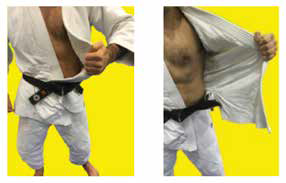
The referee should never touch an athlete's judogi or belt; this can happen in exceptional cases (e.g. Yoshi) and to safegard the safety of the athletes (e.g. in ne-waza to free the athlete's head from the judogi which prevents the evaluation of his physical state).
33. Retying hair is allowed once per athlete per contest. Further occassions are penalised with shido. The correct preparation of arranging hair is essential and is the responsibility of each athlete.
Article 18.2 Hansoku-make (Grave Infringements Group)
Hansoku-make can be indirect from an accumulation of shido penalties (see Article 18.1) or direct which is an immediate disqualification
If a direct hansoku-make is given, depending on the infringement, an athlete may or may not be allowed to continue in the competition, if applicable.
Before awarding hansoku-make, the referee must consult with the IJF Supervisors and/or IJF Referee Commission.
When there is a hansoku-make given the referee must follow the IJF procedure by completing the Direct Hansoku-make form to informthe IJF Referee Commission/Supervisor who will then inform the person running the competition.
Article 18.2.1 Hansoku-make for Dangerous Techniques
If this type of hansokyu-make is awarded the athlete can continue in the competition.
Techniques using head diving are dangerous and will be penalised with hansoku-make.
1. To “dive” headfirst, onto the tatami by bending forward and downward while performing or attempting to perform techniques such as uchi-mata, harai-goshi, kata-guruma etc. it is forbidden to somersault forward when uke is on the shoulders or the back of tori.
2. Head defence, to ensure that judo has as little trauma as possible, if uke attempts voluntarily to use the head with any movement which is dangerous for the head, neck or spine, for defence and to avoid landing in/escaping from a score he shall be penalised with hansoku-make.
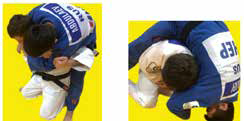
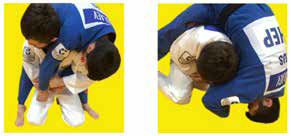
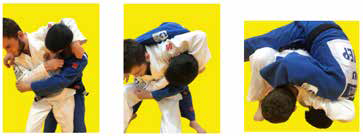
Special attention will be given to situations where tori attempts to throw his opponent during tachi-waza with, for example, seoi-otoshi, seoi-nage, sode-tsurikomi-goshi with the grip on both sleeves and koshi-guruma with both grips on the collar and uke makes an involuntary head defence.
These are examples and this situation can occur with other throwing techniques. In this situation there is no penalty for either tori or uke.
Article 18.2.2 Hansoku-make for Acts against the Spirit of Judo
If this type of hansoku-make is awarded the athlete cannot continue in the competition and will remain in the position they reached on the draw sheet (if this in the quarterfinal the position is 7th place). In round robin any remaining contest(s) will be a win by ippon for the opponent.
1. To apply kawazu-gake (to throw the opponent by winding one leg around the opponent’s leg, while facing more or less in the same direction as the opponent and falling backwards into him).
Even if the thrower twists/turns during the throwing action, this should still be considered “kawazu-gake” and be penalised. Techniques such as o-soto-gari, o-uchi-gari, and uchi-mata where the foot/leg is entwined with opponent’s leg will be permitted and should be scored.
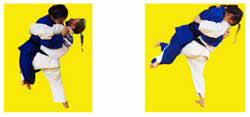
2. To apply kansetsu-waza anywhere other than to the elbow joint. To attempt such throws as harai-goshi, uchi-mata, etc., with only one hand gripping the opponent’s lapel from a position resembling ude-hishigi-waki-gatame (in which the wrist of the opponent is trapped beneath the thrower’s armpit) and deliberately falling, face down, onto the tatami is likely to cause injury and will be penalised.
No intent to throw an opponent cleanly onto his back is a dangerous action and will be treated in the same way as ude-hishigi-waki-gatame.
3. To fall directly to the tatami while applying or attempting to apply techniques such as ude-hishigi-waki-gatame (see point 2 above).
4. Uke, when behind tori, cannot reap tori's leg or legs from the inside.
5. To make any action this may endanger or injure the opponent especially the opponent’s neck or spinal vertebrae.
6. Intentionally fall backwards when the other athlete is clinging to his back and when either athlete has control of the other’s movement.
7. To lift the opponent off the tatami and forcefully push him back onto the tatami without a judo technique.
8. To disregard the referee’s instructions.
9. To make unnecessary calls, remarks or gestures derogatory to the opponent or referee during the contest.
10. To wear or have inside the judogi a hard or metallic object (covered or not).
11. Any action against the spirit of judo (this includes anything that can be described as anti-judo, for example being in the lead and, in the last seconds of the match, leaving the competition area to prevent the opponent from taking grips) may be punished by a direct hansoku-make at any time in the contest.
Article 18.3 Double Hansoku-make
If both athletes are given a hansoku-make at the same time the following rules must be applied.
Article 18.3.1 Double Hansoku-make (indirect)
In regular time or golden score if both athletes receive three shido, both athletes will be considered losers, the contest result will be recorded as 0-0, with the following consequences.
- Final - both athletes will be awarded 2nd place. Bronze medal contest - both athletes will be awarded 5th place.
- Semi-final - both athletes will be awarded 5th place.
- Quarter-final or last 8 repechage - both athletes will be awarded 7th place.
- Rounds prior to the quarter-final - both athletes considered to be losers and will remain in the position they reached on the draw sheet. They can compete in the team event if it follows an individual competition i.e. World Championships, Olympic Games, etc.
- Relevant ranking points will be assigned in the case of previous wins.
In a round robin, if both athletes are given three shido, they are considered losers for that contest only and the contest result is recorded as 0-0. They can both compete in the next contest if applicable.
In a team event, if both athletes are given three shido, they are considered losers for that match only and the contest result is recorded as 0-0. They can both compete in the next round if applicable.
In a team event golden score contest, if both athletes are given three shido, they are considered losers for that match only and the contest result is recorded as 0-0. The double disqualification category remains in the draw and golden score contest is drawn again.
Article 18.3.2 Double hansoku-make (Direct)
For a direct hansoku-make given to both athletes (in regular time or golden score), the IJF Ad Hoc Commission will decide the consequences.
For a direct hansoku-make given to both athletes in a team event golden score contest refer to Section 2.7.1.
2. U.S. Modifications and/or Comments
A. Article 18 - Prohibited Acts and Penalties – Slight Infractions (Shido)
- Negative positions will be penalized by Shido, because they are against the spirit of judo (not searching for an attack, a defensive attitude etc.…).
- Recognizing the difficulty of preparing a throwing action, the time between Kumikata and making an attack is extended to 45 seconds
- Leg grabbing or grabbing the trousers, shall be penalized by Shido.
1. Excessively Defensive Posture – video example 2016 Olympics M100kg CZE-JPN (Ducking Under video example 2016 Olympics W78kg USA-FRA) Click HERE for crushing vs Defensive Posture examples from 2020 IJF Seminar (Doha, Qatar)
2. False Attack – video - Click HERE for video of Jan 2014 IJF Rule Interpretation - Click HERE for video examples from the 2016 Ref/Coach Seminar in Tokyo Click HERE for examples from the 2020 IJF Seminar (Doha, Qatar)
3. Pulling Opponent Down into Newaza unless in accordance with Article 10 – video
4. Non-combativity – video example 2016 Olympics W70kg AUT-GBR
5. To put a hand, arm, foot or leg directly on the opponent’s face -
6. To go outside the contest area or intentionally force the opponent to go outside the contest area either in standing position or in Newaza - Example: 2016 Olympics W63kg MGL-MAR - Example pushing out 2016 OlympicsW63kg GER-BRA - Click HERE for video examples from the 2016 Ref/Coach Seminar in Tokyo - Click HERE for video of Jan 2014 IJF Rule Interpretation - Click HERE for examples from the 2020 IJF Seminar (Doha, Qatar)
7. To force the opponent with either or both arms to take a bending position without immediate attack - Click HERE for video of Jan 2014 IJF Rule Interpretation - Click HERE for crushing vs Defensive Posture examples from 2020 IJF Seminar (Doha, Qatar)
8. Avoiding the Grip – video example 2016 Olympics M100kg JPN-UKR
9. While standing, to take a grip that is not a “normal” grip, without attacking - video example 2016 Olympics W78kg FRA-BRA (note: grabbing the wrist is not kumikata - must grip gi) - Click HERE for video of Jan 2014 IJF Rule Interpretation - Examples (Pistol Grip ; Pocket Grip; Gripping the Belt; Cross Grip; One handed Grip; Cross Back Grip) Click HERE view 1 or HERE view 2 for an example of cross gripping from the 2020 IJF Seminar (Doha, Qatar)
10. Defensive Gripping (sleeve ends and screwing up the sleeve end(s) – video
11. Interlocking Fingers/gripping wrist to prevent action – video
12. Inserting fingers into opponent’s sleeve end or bottom of his trousers -
13. To bend back the opponent’s finger(s) in order to break his grip -
14. Breaking the grip of the opponent with 2 hands - Click HERE for video of Jan 2014 IJF Rule Interpretation -
15. Breaking the grip with the knee or leg -
16. Cover the upper part of the lapel of the Judogi jacket to prevent the grip -
17. Avoid uke's grip with a blow on his arm or hand -
18. Blocking the opponent's hand -
19. Disarranging the Gi (Click HERE (view 1) or HERE (view 2) for an example from the 2020 IJF Seminar in Doha, Qatar) or Untie or Retie (with the intent of delaying the contest) the Belt without Referee’s Permission -
20. All attacks or blocking with one or two hands or with one or two arms below the belt in Tachi-waza will be penalized by Shido. It is possible to grip the leg only when the two opponents are in a clear Newaza position and Tachi-waza has stopped - Click HERE for video examples in Tachiwaza. Click HERE for examples from the 2020 IJF Seminar (Doha, Qatar)
21. Encircle the end of the belt or jacket around any part of the opponents body -
22. To take the Judogi in the mouth (either his own or his opponent’s Judogi) -
23. To put a foot or a leg in the opponent’s belt, collar or lapel -
24. To apply Shime-waza using either your own or your opponent’s belt or bottom of the jacket, or using only the fingers-
25. Overstretching opponent's leg while applying shime waza or kansetsu waza -
26. Bear Hug – video -Click HERE for video examples from the 2016 Ref/Coach Seminar in Tokyo Click HERE for examples from the 2020 IJF Seminar (Doha, Qatar)
27. Dojime -
28. To kick with the knee or foot, the hand or arm of the opponent, in order to make him release his grip or kick the opponent’s leg or ankle without applying any technique -
29. If both competitors are in tachi-waza, to apply kansetsu waza or shime waza - Click HERE for examples from the 2020 IJF Seminar (Doha, Qatar) - Click HERE (view 1) and HERE (view 2) for example of Udegaeshi from the 2020 IJF Seminar (Doha, Qatar)
30. Entangling the leg without an immediate attack -
B. Article 18 - Prohibited Acts and Penalties – Grave Infractions (Hansokumake) – include videos - can continue in further matches
1. To “dive” head first, onto the Tatami by bending forward and downward while performing or attempting to perform techniques such as Uchi-mata, Harai-goshi, etc, or to fall directly backwards while performing or attempting a technique - Click HERE to view an example from the 2015 IJF Seminar (Malaga) - Click HERE for examples from 2020 IJF Seminar (Doha, Qatar)
2. Head defense -
C. Article 18 - Prohibited Acts and Penalties – Grave Infractions (Hansokumake) – include videos - cannot continue
1. To apply Kawazu-gake - click on link at the end of this page to view the 2016 Ref/Coach Seminar (Tokyo) coverage of this topic
2. To apply kansetsu waza anywhere other than the elbow - Click HERE for video examples from the 2020 IJF Seminar (Doha, Qatar)
3. To fall directly to the Tatami while applying or attempting to apply techniques such as Ude-Hishigi-Waki-Gatame - Click HERE to view an example from the 2015 IJF Seminar (Malaga) - click on link at the end of this page to view the 2016 Ref/Coach Seminar (Tokyo) coverage of this topic
4. To reap the opponent’s supporting leg from the inside when the opponent is applying a technique such as harai-goshi, etc, - click on link at the end of this page to view the 2016 Ref/Coach Seminar (Tokyo) coverage of this topic
5. To make any action that may endanger or injure the opponent, especially the opponent’s neck or spinal vertebrae, or may be against the spirit of Judo - click on link at the end of this page to view the 2016 Ref/Coach Seminar (Tokyo) coverage of this topic
6. To intentionally fall backwards when the other contestant is clinging to his back and when either contestant has control of the other’s movement -
7. To lift off the tatami the opponent who is lying on the tatami and to drive him back into the tatami - Click HERE to view an example from the 2015 IJF Seminar (Malaga)
8. To disregard the Referee’s instructions -
9. To make unnecessary calls, remarks or gestures derogatory to the opponent or Referee during the contest -
10. To wear a hard or metallic object (covered or not) -
11. Any action against the spirit of Judo -
Click HERE (view 1) to view an example of Kamibasami (HERE view 2) from 2020 IJF Seminar (Doha, Qatar)
Click HERE for an example of intentionally stepping on the opponents foot to initiate a throw (against the spirit of Judo)
Safety: Summary: Bridging to avoid a back landing will be awarded Ippon to tori. Voluntary use of the head for defense to avoid landing in/escaping from a score will be a direct Hansoku Make. The competitor will only lose the match (similar to head diving). Click HERE view 1 or HERE view 2 to view an example of Head Deflection from 2020 IJF Seminar (Doha, Qatar)
Landing on both elbows or two arms or one elbow and one hand will be awarded a Waza-ari. Landing on one elbow will not be scored.
Any action to avoid competing or purposefully attempting to avoid competing to utilize time on the clock will be considered acting against the spirit of judo and will be penalized with Hansoku Make.
• The committee examined the rules with regard to safety to ensure that judo has as little trauma as possible.
• If Uke attempts to avoid landing on their back by any movement which is dangerous for the head, neck or spine, they shall be penalized with Hansokumake. •The competitor loses this contest, but may continue in the competition if the situation in the tournament system allows it.
• In order not to give a bad example for young judokas, the landing on both elbows, both hands or one elbow and one hand is considered valid and evaluated as Waza-ari.
• Landing on only one elbow is invalid and can not be used for assessment. Uke's elbow must be posted and torso must not touch tatami.
• Anti judo will be immediately penalized as an act against the spirit of Judo. No change. If an athlete is running to avoid competing in a judo contest or to escape from the opponent, that competitor will be considered as acting against the spirit of judo and will be penalized with Hansoku Make.
Click HERE for video of Jan 2014 IJF Rule Interpretation (Shido without returning contestants to their starting positions
Click HERE for video examples from the 2016 Ref/Coach Seminar in Tokyo - Hansoku-make or not - misc. (wakigatame type throws, reaping the supporting leg from the inside, Kawazu-gaki, etc.)
Click HERE to continue to the next training module
Click HERE to return to the INDEX.

